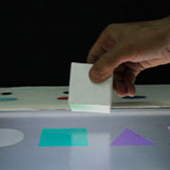There are mainly two types of TUI:
6.1 Passive TUIs
6.2 Active TUIs
6.1 Passive TUIs:
Digital information is represented in tangible and/or intangible form; however participation of the user with the product is relatively less. User may not directly interact with the product, but indirectly control and manipulate the product state.
Pupspy presents passive tangible user interface. A metaphor of dog is used to represent pupspy that protects your computer from virus attacks. Once the virus in the computer is detected, pupspy starts barking signifying the threat. If virus from the system is removed, pupspy wages his tail & ears start moving.
Here, users are not directly interacting with pupspy. However, there is an indirect interaction with the product through computers.

6.2 Active TUIs:
Users are actively involved in interacting with digital information. The participation of the user is very high & response from the system is immediate.
Reactable represents active tangible user interface. The reactable is a multi-user electro-acoustic music instrument with a tabletop tangible user interface, which is developed at the MTG in Barcelona. Blocks of different shapes are placed on the table top, moving them vertically, horizontally or rotating them creates music or sound effects.
In reactable, users are directly interacting with information (in this case music/sound effects) and based on users’ actions and manipulation, the contents are changing.


